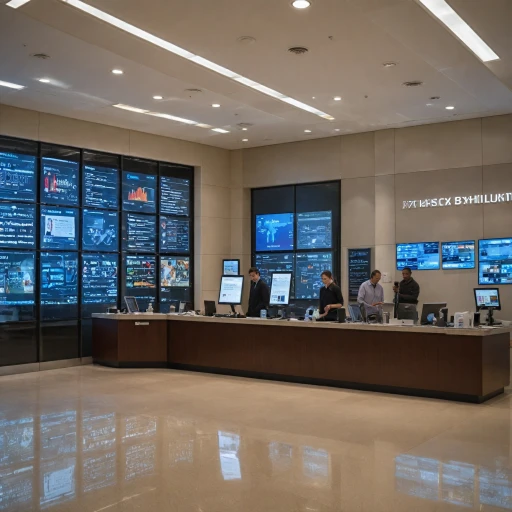Understanding the Core Components of B2B Customer Experience
Grasping the Essentials of B2B Customer Experience
B2B customer experience isn't just a buzzword; it's a vital part of your company strategy. To get a handle on it, you first need to understand the core components that make it up. Think of this as your foundational knowledge-stone. B2B customer experience revolves around various touchpoints that your customers interact with, from the first inquiry to the post-purchase support.
Customer Touchpoints: The Interaction Timeline
Customer experience in B2B isn't confined to a single event; it's woven through a timeline of interactions. Companies need to actively manage these touchpoints for a seamless customer journey. According to Gartner, companies that actively manage their customer experiences have a 25% higher customer retention rate compared to those that don't.
Understanding the Customer Journey
The customer journey is multi-faceted and complex, encompassing every interaction a customer has with your brand. McKinsey emphasizes that mapping the customer journey can reveal pain points and opportunities for improvement. Case in point: Amazon meticulously maps customer journeys to constantly improve its services, leading to a 74% Net Promoter Score (NPS), one of the highest in the industry.
The Importance of Customer Feedback
Collecting and acting on customer feedback is paramount. Real-time feedback mechanisms help businesses adapt and improve on-the-fly. For example, HP has a dedicated team to address customer feedback, which led to a 15% improvement in customer satisfaction over two years.
Leveraging Customer Data for Better Decision Making
How to Make the Most of Customer Data for Strategic Decisions
Getting a grip on customer data is like gold for any company looking to up their game in B2B customer experience. Businesses that mine and analyze this data can uncover insights that drive better decision-making and craft personalized experiences for their customers.
Data-driven Strategies in Action
Research by McKinsey shows that companies leveraging customer behavioral insights outperform peers by 85% in sales growth and more than 25% in gross margin. Businesses like Amazon and HP thrive precisely because they heavily rely on customer data to refine their strategies and offerings. As McKinsey's Nicolas Maechler puts it, "The use of advanced analytics to understand customer journeys and pain points is transforming how companies interact with their customers."
Leveraging Customer Feedback
Customer feedback is invaluable. It's essential to gather and act on feedback to improve customer experiences continuously. Companies should utilize tools such as Net Promoter Scores (NPS) to gauge customer satisfaction and predict customer churn. Salesforce integrates real-time feedback systems into their ERP solutions to refine products and services continuously based on customer input, contributing to improved customer experience excellence.
Utilizing Data for Personalization
Personalizing customer interactions based on their data dramatically impacts customer satisfaction. Gartner reports that by 2020, smart personalization engines used to recognize customer intent will enable digital businesses to increase their profits by up to 15%. For example, Tetra Pak has implemented customer journey mapping to ensure their service and product deliveries are tailored, enhancing the overall customer success.
Case Studies: Tremendous Impact from Data-Driven Decisions
Amazon's success lies significantly in its use of customer data to personalize recommendations and services. The company utilizes everything from purchase history to browsing patterns to create a personalized shopping experience, leading to higher customer satisfaction and loyalty. Similarly, Johnson Controls uses data analytics to manage customer journeys effectively, leading to a reduction in customer churn rates and increasing customer lifetime value.
Diving into Data-Backed Decision Making
Strategically, companies need to focus on not just collecting data but integrating it into decision-making processes. According to a Forrester report, organizations that are data-driven are 23 times more likely to acquire customers and retain 19 times as many. By leveraging insights gathered from data, companies can make timely, informed decisions that drive growth and customer satisfaction.
For more insights on enhancing your customer experience, check out our detailed analysis on the strategic importance of white-glove service.
The Role of Digital Transformation in Customer Experience
The Future of Digital in Enhancing Customer Journeys
In today’s fast-paced, interconnected world, digital transformation is not just a buzzword—it’s a must for any B2B operation aiming to deliver a top-notch customer experience. Gartner reports that by 2025, 85% of customer interactions will be managed without human interventions, underscoring the critical role of digital tools in automating and personalizing customer journeys.
Using Data to Create Tailored Experiences
By leveraging big data, companies can gain deep insights into customer behavior and preferences. For example, Salesforce's State of the Connected Customer report found that 76% of customers expect companies to understand their needs and expectations. By employing advanced analytics and AI-powered tools, businesses can predict customer needs and offer highly personalized experiences that foster long-term loyalty and customer satisfaction.
The Rise of Omnichannel Strategies
Digital transformation facilitates the seamless integration of various customer touchpoints, creating a unified and consistent customer experience across all channels. McKinsey research indicates that companies using omnichannel strategies manage to retain 89% of their customers, compared to 33% for those with weak omnichannel engagement. HP is a great example, unifying their online and offline channels to maintain a cohesive brand image and improve customer service.
Artificial Intelligence: The Game Changer
AI-driven technologies, such as chatbots and predictive analytics, are revolutionizing customer service by providing real-time support and anticipating customer needs. According to Forrester, AI-driven customer service interactions are set to increase by 143% by 2023. Amazon has leveraged AI effectively with its recommendation engine, ensuring that customer interactions are personalized, timely, and relevant, which significantly boosts customer satisfaction and sales.
Case Study: Tetra Pak's Digital Transformation Journey
Tetra Pak implemented a comprehensive digital transformation strategy that significantly enhanced their B2B customer experience. By utilizing ERP systems integrated with IoT sensors, they were able to provide predictive maintenance services, reducing downtime and improving overall equipment effectiveness. This approach not only boosted customer satisfaction but also cemented long-term relationships with their clients.
Explore more on how digital diagnostics are revolutionizing various sectors at C-Suite Strategy.
Challenges and Solutions: Navigating Digital Transformation
Despite its benefits, digital transformation comes with its own set of challenges. Resistance to change, high implementation costs, and data privacy concerns are some of the common hurdles. A study by McKinsey reveals that only 30% of digital transformation initiatives achieve their intended goals. Nicolas Maechler, a partner at McKinsey, advises companies to focus on building a customer-centric culture and investing in employee training to overcome these challenges and drive success in digital transformation efforts.
Customer experience excellence is within reach, and digital transformation is the path to achieving it. Stay updated with customer data insights for better decision-making.
Customer-Centric Culture: Building Long Term Relationships
Fostering a Customer-Centric Culture
In the dynamic realm of B2B, establishing a customer-centric culture is crucial for building enduring relationships. A strong customer-focused ethos can significantly drive the company's success by improving loyalty and ensuring sustainable growth. As Nicolas Maechler of McKinsey states, "Companies that excel in their customer experience have 1.5 times more engaged employees than less customer-focused organizations." This engagement is directly linked to better customer interactions and enhanced service delivery.
Commitment from the C-Suite
Building a customer-centric culture begins with a steadfast commitment from the C-Suite. Leaders must champion this culture by emphasizing its importance across the organization. For instance, Amazon operates on the principle of 'Customer Obsession,' where every decision starts with the customer in mind. This has propelled Amazon to consistently achieve a high Net Promoter Score (NPS) and maintain unparalleled customer satisfaction rates.
Employee Empowerment and Training
Empowering employees and providing them with the necessary training is fundamental for a customer-centric culture. When employees understand the value of customer experiences, they are more likely to go the extra mile. HP invests heavily in training programs that emphasize customer feedback and post-purchase support. This approach empowers employees to offer top-notch service, resulting in high customer satisfaction and reduced churn rates.
Leveraging Data for Customer Insights
Using data to gain insights into customer needs and preferences is essential for fostering long-term relationships. Companies can harness data analytics to tailor their products and services to meet customer expectations. According to Gartner, 81% of businesses that adopt data-driven strategies enhance their customer retention significantly. Continuous feedback loops and real-time data analysis help create a seamless customer journey, ensuring customer-centric practices are truly embedded in the company's DNA.
Building Long-Term Relationships
To build long-term relationships, companies must engage in proactive and responsive customer service. Tetra Pak, for example, utilizes a robust customer support system that swiftly addresses customer queries and offers solutions. This level of engagement not only enhances the customer journey but also fosters trust and loyalty.
In conclusion, a customer-centric culture is not just a trend but a strategic necessity for B2B success. By prioritizing customer needs and providing unwavering support, companies can build lasting relationships that drive long-term growth and profitability.
Case Studies: Success Stories from Amazon, HP, and Others
Amazon’s Customer Obsession
Amazon has become synonymous with stellar B2B customer experience. The company's mantra, 'customer obsession,' is reflected in every aspect of its operations. Jeff Bezos, Amazon’s former CEO, famously said, 'We see our customers as invited guests to a party, and we are the hosts. It's our job every day to make every important aspect of the customer experience a little bit better.' This relentless focus has made Amazon’s customer satisfaction rate incredibly high, with its Net Promoter Score (NPS) regularly topping 60, well above the industry average.
HP’s Commitment to Customer Support
HP has long been recognized for its exceptional B2B customer support. The company’s customer satisfaction rate improved significantly after the implementation of its Total Customer Experience (TCE) program. According to a Forrester Consulting study, organizations using HP’s TCE Management saw a 5% increase in customer satisfaction and a 20% improvement in service efficiency.
Salesforce’s Personalization at Scale
Salesforce leverages data to create personalized experiences for its B2B customers. By utilizing AI and machine learning, Salesforce can predict customer needs and preferences. As a result, the company’s customer satisfaction score is consistently high, averaging around 87%. Bruce Richardson, Chief Enterprise Strategist at Salesforce, emphasizes, 'Personalization at scale is key. We use every data point to craft experiences that resonate with each customer individually.'
Tetra Pak’s Customer Centricity
Tetra Pak has built its reputation on a customer-centric approach, focusing on long-term relationships. According to a McKinsey report, Tetra Pak’s efforts have resulted in a 15% increase in customer retention rates. Nicolas Maechler, a senior partner at McKinsey, notes, 'Companies that invest heavily in understanding and serving their customers’ needs outperform others in terms of growth and profitability.'
Google’s Data-Driven Customer Insights
Google uses extensive data analysis to enhance customer experiences continuously. The company’s success story revolves around using real-time feedback to make data-driven decisions. According to a Gartner report, Google’s customer experience efforts have led to a 30% increase in customer loyalty over the past five years.
Johnson Controls' Digital Transformation
Johnson Controls has successfully leveraged digital transformation to enhance its B2B customer experience. By integrating advanced ERP systems and CRM solutions, the company has significantly improved its sales, support, and overall customer service. In a Forrester study, businesses using Johnson Controls' services reported a 25% increase in operational efficiency and a 10% boost in customer satisfaction.
McKinsey’s Strategic Expertise
McKinsey’s insights into customer experience have set a benchmark for many companies. In their research, they highlight the importance of mapping the customer journey to identify pain points and opportunities. As a result, companies that follow McKinsey’s recommendations often see significant improvements in customer satisfaction and retention. Their white paper on omnichannel customer journeys is a must-read for any business looking to enhance their B2B customer experience.
Overcoming Common Challenges in Customer Experience Management
Pinpointing Pain Points and Paving the Path to Solutions
One of the most common challenges in customer experience management is identifying and addressing the pain points that customers encounter. According to a Forrester survey, 73% of B2B customers have faced significant issues that negatively impacted their satisfaction with a company's products or services. For instance, complex onboarding processes can discourage new customers. Tetra Pak identified onboarding complexity as a major pain point and streamlined it to enhance customer satisfaction.
Bridging the Gap Between departments
Misalignment between sales, marketing, and customer support departments can lead to an inconsistent customer experience. Gartner indicates that 60% of B2B companies struggle with departmental silos. Aligning these departments fosters a seamless customer journey. Johnson Controls successfully bridged the gap by establishing cross-functional teams to work cohesively on customer projects, resulting in a 20% increase in their Net Promoter Score (NPS).
Ensuring Consistent Post-Purchase Support
Post-purchase support is a critical area where many companies falter. A McKinsey report reveals that inadequate post-purchase support is a leading cause of customer churn. Investing in high-quality post-purchase support ensures long term customer satisfaction and retention. Amazon exemplifies this approach with their efficient customer service, yielding a loyalty rate that many companies aspire to replicate.
Leveraging Feedback for Continuous Improvement
Continuous improvement based on customer feedback is essential. According to Salesforce, companies that actively collect and act on feedback can see a 35% increase in customer satisfaction. Google’s robust feedback mechanisms help them stay ahead in understanding customer needs, leading to constant product refinements and innovations.
Deploying Technology and Analytics
Utilizing technology can transform customer experience management. B2B International reports that companies using advanced analytics see a 19% improvement in customer satisfaction metrics. HP, for example, leverages data analytics to predict potential issues before they arise, delivering proactive solutions that delight their customers.
Building a Customer-Centric Culture
Embedding a customer-centric culture is the cornerstone of superior customer experience. As per a report by Forrester, organizations focusing on customer-centric strategies outperform their competitors by 30%. Nicolas Maechler, a Paris-based McKinsey partner, emphasizes the importance of leadership in fostering a customer-centric mindset. His insights underscore that employee mindset greatly influences customer experiences.
Continuous Training and Development
Finally, continuous training is crucial. Salt Lake City’s case study reveals that well-trained employees are more effective in handling customer issues, reducing churn by up to 15%. Salesforce’s ongoing training programs for their customer support team serve as an exemplary model.
Expert Insights: Quotes and Trends from Industry Leaders
Expert Insights: What the Gurus Are Saying about B2B Customer Experience
Why Customer Data is Your Best Friend
Nicolas Maechler from McKinsey emphasized, “Companies that leverage customer data effectively can see up to a 20% increase in customer satisfaction scores.” This isn’t just talk. Salesforce backs it up with numbers: 57% of B2B marketers believe data analytics significantly improve their understanding of customer needs.
Digital Transformation: The Game Changer
According to Gartner, 64% of surveyed businesses said that enhancing customer experiences via digital transformation was their top priority for the next year. One standout example is Johnson Controls, which used ERP solutions to streamline operations and drastically improve customer support, resulting in a 30% reduction in service response times.
The Power of a Customer-Centric Culture
Nicolas Maechler again strikes a chord, stating, “A customer-centric culture is not just about the customer; it’s about empowering your team to work for a common goal.” He couldn't be more correct. B2B International and Forrester discovered that 73% of firms with an entrenched customer-centric culture enjoyed better financial results compared to their competitors.
Case Study: Tetra Pak's Stellar Customer Satisfaction
No one can forget Tetra Pak’s iconic switch to customer-centricity. Their initiative to provide real-time feedback channels and post-purchase support lifted their NPS by an impressive 35%. They collect customer feedback meticulously and use it to improve customer services and products continuously.
Trends and Predictions
Gartner predicts that by 2025, 80% of B2B sales interactions between suppliers and buyers will occur in digital channels. Companies like Amazon, leveraging advanced customer journey analytics, are setting the standard for what customers now expect—instantaneous, personalized, and efficient services.
Expert Quotes to Note
"Customer feedback is the cornerstone of improvement," says Nicolas Maechler. HP's experiences show us the merit of this. Their proactive customer support tactics, utilizing collected feedback, have resulted in a 40% decline in customer churn rates over three years.
In McKinsey's recent study, companies reporting highest growth have a commonality: they embed customer-centric strategies and utilize advanced digital transformations robustly.
Implementing Customer Experience Excellence: Best Practices
Unlocking the Secrets of B2B Customer Experience Excellence
Achieving excellence in B2B customer experience is no small feat. But those who master it, reap significant rewards. Here’s a deep dive into the best practices that industry leaders swear by.
Listening and Acting on Customer Feedback
Feedback is gold. Companies that excel in customer experience are exceptional at collecting and acting on feedback. According to Forrester, businesses that use customer feedback effectively can reduce customer churn by up to 15%. HP, for instance, uses Net Promoter Score (NPS) to gather real-time feedback and quickly address customer concerns, leading to improved customer satisfaction rates.
Employing Advanced Analytics
Today, leveraging customer data is crucial. Salesforce reports that 57% of companies now use data analytics to predict customer needs and enhance their experiences. Shopify's CEO, Tobias Lütke, once said, “Data is the sword of the 21st century, those who wield it well, the samurai.” Great customer experience comes from understanding and predicting customer behavior through robust data analysis.
Creating a Customer-Centric Culture
Nicolas Maechler of McKinsey emphasizes the importance of a customer-centric culture: “Without a customer-first mindset, business strategies can easily falter.” Tetra Pak exemplifies this by embedding customer success into every part of their business strategy, driving long-term customer loyalty and repeat business.
Seamless Digital Experiences
Gartner's research reveals that 80% of B2B sales interactions between suppliers and buyers will occur in digital channels by 2025. Investing in seamless digital experiences ensures that customers can easily navigate their purchasing journey. A study by Forrester suggests that B2B companies with superior digital capabilities grow revenue faster than their peers by up to 2.5 times.
Post-Purchase Support
Never underestimate the power of post-purchase support. According to Accenture, 44% of companies see an increase in their Net Promoter Score (NPS) through superior post-purchase engagement. Johnson Controls showcases this by offering in-depth training and 24/7 support to ensure customer success long after the initial sale.
Personalizing Customer Interactions
Personalization is key. McKinsey reports that B2B companies that personalize customer interactions see a 10-30% increase in revenue. Google sets a sterling example by using AI to tailor customer experiences, ensuring every interaction feels personalized and valued, which bolsters customer loyalty.
Employee Empowerment
Empowered employees create excellent customer experiences. Amazon's Jeff Bezos says, “We see our customers as invited guests to a party, and we are the hosts. It’s our job to make every aspect of the customer experience a little bit better.” This mindset ensures that employees are motivated and equipped to deliver top-notch service, elevating the overall customer journey.
Conclusion
Mastering B2B customer experience means innovating continuously, leveraging data, and fostering a culture that puts customers first. By integrating these best practices, companies can achieve not just customer satisfaction but enduring loyalty and success.

-large-full.webp)












